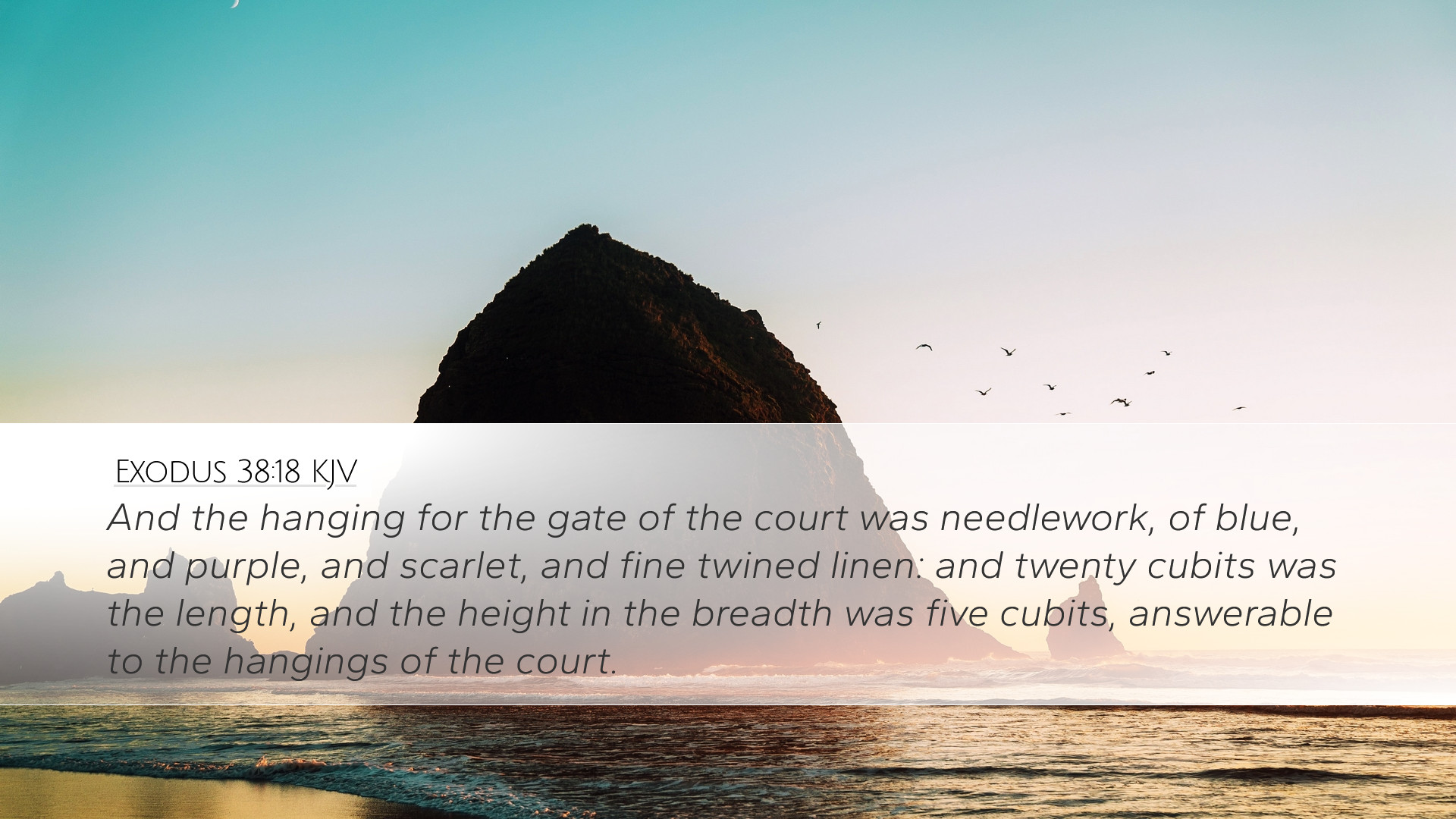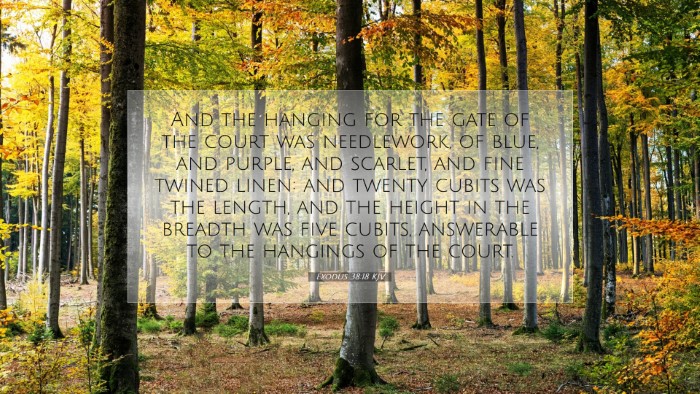Commentary on Exodus 38:18
Exodus 38:18 states, "The screen of the gate for the court was made of blue, purple, and scarlet yarn and finely twisted linen—the work of an embroiderer. It was twenty cubits long and, like the court, five cubits high, with four posts and their four bases."
This verse encapsulates important details regarding the structure and design of the entrance to the Tabernacle's court. Through the examination of this scripture, we can derive several theological and practical insights that can benefit pastors, students, theologians, and Bible scholars.
1. The Significance of Colors and Materials
The description of the materials used in the screen of the gate is rich with symbolic significance. The use of blue, purple, and scarlet yarn corresponds to both royal and divine attributes. As Matthew Henry points out, blue represents the heavenly origin, purple signifies royalty and nobility, and scarlet suggests both sacrifice and atonement. Thus, the entrance to the court visually foreshadows the coming of Christ, who embodies these elements through His divine nature, kingship, and sacrificial role.
Albert Barnes emphasizes that the finely twisted linen indicates purity and righteousness, reinforcing the idea that entering the sacred space demands a certain holiness that is only achieved through God’s provision and grace. The material used not only serves an aesthetic purpose but also conveys the holiness associated with God’s dwelling place.
2. The Construction as Divine Instruction
The precise details regarding the measurements and specifications of the screen reveal God's meticulous nature. Adam Clarke notes that the dimensions—twenty cubits long and five cubits high—indicate that the entrance itself is intended to be both functional and symbolic. The height signifies that it is a barrier to the holy, inviting in the righteous while simultaneously indicating that it is not an open space for all.
"The work of an embroiderer" (Exodus 38:18) indicates skilled craftsmanship designated for components of the Tabernacle. The very act of embroidery implies effort, artistry, and intentional design that reflects God’s creative nature. It invites reflection on the importance of diligence and excellence in ministry work.
3. Theological Implications of the Entrance
The screen serves as a threshold between the secular world and the sacred space of the Tabernacle. Matthew Henry articulates that just as this screen delineates the court's boundary, so does Christ serve as the ultimate mediator between God and humanity. Just as one passed through the screen to access the presence of God, believers today approach God through Christ, the door of salvation (John 10:9).
Albert Barnes further elaborates that the screen's function ensures that entry into God’s presence is not casual or taken lightly. This illustrates the necessity for reverence, respect, and understanding of the divine nature of God, a principle that remains critical in current worship practices.
4. The Screen as a Symbol of Division and Access
The screen represents both division and access. It separated the sacred from the common while still allowing for interaction. Adam Clarke comments that this dual role is fulfilled in Christ, who divides the sinful from the righteous but also provides a means for reconciliation and communion with God. Pastors and teachers can use this understanding to teach congregations about the importance of Christ as the way to God, highlighting the joy and responsibility that accompanies this access.
5. Application for Modern Believers and Leaders
The imagery presented in Exodus 38:18 is not merely historical but serves as a call to action and reflection for believers today. Pastors can encourage their congregations to examine their relationship with God, emphasizing that while access through Christ is available, it is also essential to approach Him with holiness and sincerity.
- Engagement in Spiritual Disciplines: Encourage believers to engage in regular prayer and Scripture study to cultivate a deeper relationship with God.
- Community Worship: Emphasize the importance of gathering as a community to worship, recalling the communal aspects of entering the Tabernacle together.
- Awareness of Holiness: Teach congregants about the nature of God’s holiness and the need to live lives set apart, reflecting the purity denoted by the materials used in the screen.
6. Conclusion
In Exodus 38:18, we find multifaceted truths that weave together themes of artistry, sacrifice, divine instruction, and bold access to God. The insights drawn from public domain commentaries illuminate the theological significance of the physical details surrounding the Tabernacle, ultimately pointing to Jesus Christ as the fulfillment of all that the Tabernacle represents. Engaging deeply with this verse equips scholars, students, and leaders not only to understand the text but to communicate its profound implications to their communities effectively.


